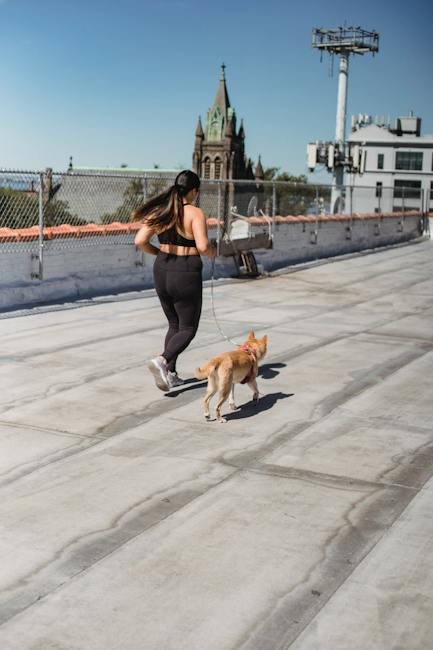Imagine a world where dogs trot freely through the park, their tails wagging with unbound enthusiasm as they explore, play, and interact with their fellow furry friends. In this utopian canine realm, they obey commands with unwavering loyalty, even without the constraints of a leash. It may sound too good to be true, but with the power of positive reinforcement, off-leash dog training can transform this dream into a joyful reality. With a gentle nudge of encouragement, a treat-filled palm, and heaps of praise, dog owners can unlock the true potential of their beloved four-legged companions. Welcome to the realm of off-leash dog training using positive reinforcement, an art that not only strengthens the bond between human and dog but also empowers canines to experience freedom in its purest form.
Table of Contents
- The Basics of Off-Leash Dog Training: Using Positive Reinforcement to Strengthen Your Bond
- Understanding the Importance of Positive Reinforcement in Off-Leash Training
- Effective Techniques for Teaching Off-Leash Control with Positive Reinforcement
- Setting Up for Success: Creating an Enriched Environment for Off-Leash Training
- Building Reliability and Responsiveness: Advanced Tips for Off-Leash Dog Training
- Q&A
- In Summary

The Basics of Off-Leash Dog Training: Using Positive Reinforcement to Strengthen Your Bond
Off-leash dog training is a fantastic way to deepen the trust and connection between you and your furry friend. By using positive reinforcement techniques, you can not only teach your dog to follow commands off-leash but also create a strong bond built on love and trust.
Here are some key tips to get you started on the path to successful off-leash dog training:
- Patience is key: Remember that off-leash training requires time and consistency. Be patient with your dog as they learn and reinforce their good behavior with rewards and praise. Consistency will help them understand what is expected of them.
- Focus on recall: Start by teaching your dog a strong recall command. This will ensure that they come back to you when called, even in distracting environments. Practice this command using positive reinforcement techniques and gradually increase the level of distractions to ensure their reliability.
- Positive reinforcement: Reward your dog with praise, treats, and play for every desired behavior. Positive reinforcement strengthens their understanding that good behavior leads to rewards, making them more likely to repeat those behaviors off-leash.
Remember that off-leash dog training requires a safe and controlled environment. Start in a secure, fenced area before progressing to open spaces. Always prioritize your dog’s safety and keep in mind that training takes time and dedication. With patience and positive reinforcement, you can enjoy the freedom of off-leash adventures with your beloved furry companion!

Understanding the Importance of Positive Reinforcement in Off-Leash Training
When it comes to off-leash training, positive reinforcement is a powerful tool that should not be underestimated. It serves as a way to encourage desired behavior while building a strong bond between you and your furry companion. By using positive reinforcement techniques, such as treats, praise, and rewards, you can effectively communicate what behaviors you want to see, making the training process enjoyable for both you and your dog.
One of the key benefits of positive reinforcement is that it helps your dog associate obedience with positive experiences. This creates a positive learning environment, where your dog becomes eager to participate and goes above and beyond to please you. Remember, dogs are highly motivated by praise and treats, and they thrive when their efforts are acknowledged and rewarded.
It’s important to keep in mind that positive reinforcement goes beyond just using treats and rewards. It should also involve clear communication, consistency, and patience. Set clear expectations and reward your dog each time they meet them. Be consistent in your training methods, as this will prevent confusion and allow your dog to learn efficiently. Additionally, always have patience, understanding that learning takes time and practice.
- Use treats as a positive incentive for desired behavior.
- Provide verbal praise, patting, or belly rubs as a form of reward.
- Offer toys, playtime, or other enjoyable activities to reinforce good behavior.
- Be consistent in the use of rewards to reinforce specific commands or actions.
- Stay patient and avoid punishment-based methods, as they can deter the learning process.
By embracing and implementing positive reinforcement in your off-leash training, you are not only fostering a stronger bond with your dog but also creating a happy and well-behaved companion. Remember, a well-trained dog is a confident and joyful one!

Effective Techniques for Teaching Off-Leash Control with Positive Reinforcement
Teaching off-leash control to your dog can be both exciting and challenging. It requires patience, consistency, and the use of positive reinforcement. By following these effective techniques, you can help your furry friend learn to obey commands even when they are not physically restrained by a leash.
1. Establish a strong foundation: Before attempting off-leash training, ensure your dog has a solid understanding of basic obedience commands such as sit, stay, and come. This foundation will provide a framework for further training and improve off-leash control.
2. Gradual freedom: Start by practicing off-leash training in a secure, enclosed area such as a fenced yard or a quiet park. Begin with short sessions and gradually increase the distance and duration. Remember to reward your dog with treats, praise, or their favorite toy whenever they respond correctly to your commands.
3. Proofing and distractions: As your dog becomes more proficient, it’s essential to introduce distractions gradually. Start with mild distractions such as cars or people in the distance, and gradually progress to more challenging ones. This step will help your dog develop the ability to maintain focus and respond to commands despite distractions.
In conclusion, teaching off-leash control using positive reinforcement can be a rewarding experience for both you and your furry companion. By establishing a strong foundation, gradually increasing freedom, and introducing distractions, you will help your dog gain the skills needed to exhibit excellent off-leash control. Remember to remain patient, consistent, and always celebrate your dog’s successes in their learning journey.
Setting Up for Success: Creating an Enriched Environment for Off-Leash Training
When it comes to off-leash training, creating an enriched environment is key for setting both you and your furry friend up for success. By providing a stimulating and safe space, you can enhance your training sessions and promote a positive learning experience. Here are a few tips to help you create an enriched environment:
- Secure the area: Safety always comes first. Ensure the training area is securely fenced or enclosed to prevent your dog from wandering off. This will give you peace of mind and allow your pup to focus solely on their training.
- Add interactive elements: Incorporate toys, tunnels, and agility equipment into the training space. These interactive elements not only engage your dog’s mind and body but also encourage exploration and playfulness. This will make training sessions more enjoyable for your pup and keep them motivated throughout.
- Vary the terrain: A diverse environment can aid in your dog’s adaptability and confidence. Include different surfaces like grass, sand, or gravel to expose your furry companion to various textures. This will broaden their sensory experiences and prepare them for a range of outdoor environments.
- Provide sensory stimulation: Enrich your training area with sights, sounds, and smells that mimic real-life situations. This can include playing nature sounds, using scent-based puzzles, or introducing friendly distractions like a well-behaved dog or a squirrel plush toy. This exposure will help your pup develop focus and impulse control.
Remember, creating an enriched environment for off-leash training is more than just a physical setup; it’s about fostering a positive and engaging atmosphere that supports your dog’s learning and growth. By implementing these tips, you’ll be well on your way to achieving greater success in your off-leash training sessions!
Building Reliability and Responsiveness: Advanced Tips for Off-Leash Dog Training
When it comes to off-leash dog training, one of the ultimate goals is to establish reliability and responsiveness in your furry friend. To take your training skills to the next level, here are some advanced tips that can help you achieve a well-behaved, confident, and off-leash obedient dog:
- Consistency is Key: Consistency plays a crucial role in training your dog. Ensure that you use the same commands and cues consistently throughout the training process. By doing so, your dog will grasp the meaning of each command and respond appropriately, enhancing reliability.
- Proofing in Various Environments: Dogs can respond differently in different environments. To build reliability, it’s important to expose your dog to various environments and distractions gradually. Start in a controlled setting, then gradually introduce distractions such as other dogs, people, or new surroundings. This will help your dog stay focused on your commands regardless of the situation.
- Reward-Based Training: Utilize positive reinforcement techniques to motivate and reward your dog for desired behavior. Reward-based training, such as using treats or praise, can enhance responsiveness and create a positive association with training. It encourages your dog to repeat the desired behavior, making training a more enjoyable experience.
- Proofing Distance and Duration: As your dog progresses, gradually increase the distance from which you give commands and the duration they are expected to remain in the desired behavior. This helps build reliability over longer distances and timeframes, ensuring your dog remains responsive and obedient even from a distance.
By implementing these advanced training tips, you’ll be well on your way to building reliability and responsiveness in your off-leash dog training. Remember, patience and consistency are key factors in achieving success, so keep practicing, and enjoy the journey of training your four-legged companion to be the best they can be!
Q&A
Q: Is off-leash dog training using positive reinforcement effective?
A: Yes, off-leash dog training using positive reinforcement is effective because it rewards the dog for desirable behavior rather than punishing for unwanted behavior, leading to better obedience and a stronger bond between the dog and its owner.
Q: How does positive reinforcement work in off-leash dog training?
A: Positive reinforcement involves using rewards, such as treats or praise, to reinforce desired behaviors. In off-leash training, this type of reinforcement encourages dogs to choose appropriate actions willingly, resulting in a more reliable off-leash behavior.
Q: Can off-leash training work for all dogs?
A: Off-leash training can work for most dogs, regardless of breed or age, as long as the training is tailored to the individual dog’s needs, utilizing positive reinforcement methods consistently and with patience.
Q: What are the benefits of off-leash dog training using positive reinforcement?
A: Off-leash dog training using positive reinforcement provides dogs with more freedom, allowing them to explore, exercise, and interact with their environment, while still maintaining control and ensuring their safety.
Q: Is it possible to train a dog to be reliable off-leash in all situations?
A: While it is possible to train a dog to be reliable off-leash in many situations, it is essential to remember that external factors, such as distractions or unpredictable environments, can affect a dog’s behavior. Continued training and reinforcement are necessary to increase reliability in different scenarios.
Q: How long does it typically take to train a dog for off-leash reliability?
A: The timeframe for training a dog for off-leash reliability can vary depending on factors such as the dog’s age, breed, and previous training experiences. However, with consistent and positive training methods, many dogs can make significant progress within several weeks or months.
Q: What are some important considerations when using off-leash dog training?
A: It is crucial to ensure that the training environment is safe, minimize potential distractions, and gradually increase off-leash freedom as the dog demonstrates reliability. It’s advisable to consult with a professional trainer to address any specific concerns or challenges during the training process.
Q: Are there any risks associated with off-leash training for dogs?
A: Off-leash training carries some inherent risks, such as the possibility of the dog running off or encountering hazards. Therefore, proper supervision, selecting appropriate training areas, and ensuring a solid recall command are vital to mitigate any potential risks.
Q: Can off-leash training replace the use of a leash altogether?
A: While off-leash training aims to provide dogs with increased freedom, it is important to remember that leashes are still necessary in certain situations, such as in busy areas or when required by regulations. Off-leash training should be seen as a supplement to leash training, not a complete replacement.
In Summary
As we bid farewell to this enlightening journey into the world of off-leash dog training using positive reinforcement, we hope you’ve discovered a newfound appreciation for the incredible potential that lies within our furry companions. Through ingenious methods and gentle encouragement, we have learned that the bond between a dog and their human can transcend boundaries, leading to a harmonious coexistence built on trust and respect.
As we conclude, let’s reflect on the transformative power of positive reinforcement, which beautifully demonstrates that force is not synonymous with efficacy. By embracing the notion of reward-based training, we have witnessed canines blossoming into their full potential, eagerly learning and gracefully responding to our guidance. These dogs, once tethered to their leashes, now dance freely beside us, a symphony of pure joy and uninhibited liberation.
But let us remember that this journey does not end here. The knowledge gained within these pages is an invitation to a lifelong commitment, a roadmap to nurturing the unbreakable bond between devoted guardians and their ever-loyal companions. It urges us to venture forth, equipped with compassion and patience, to continue exploring the vast possibilities that positive reinforcement holds.
So, as we part ways, may the principles of this training methodology permeate your every interaction with your four-legged family members. May it serve as a gentle reminder to replace dominance with understanding, punishment with encouragement, and coercion with collaboration. And may you witness, in the eyes of your furry friend, the sparkle of a shared language, paving the way to boundless adventures and uncharted territories.
Embrace this newfound wisdom, dear readers, and spread its message far and wide. Let us cultivate a world where dogs roam freely, guided not by force but by love, and we, their humble companions, revel in every tail wag, knowing that it was born out of trust nurtured through the art of positive reinforcement.
As an affiliate, my content may feature links to products I personally use and recommend. By taking action, like subscribing or making a purchase, you’ll be supporting my work and fueling my taco cravings at the same time. Win-win, right?
Want to read more? Check out our Affiliate Disclosure page.